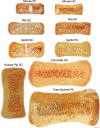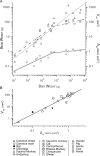Comparative morphology of rodent vestibular periphery. II. Cristae ampullares
- PMID: 15240768
- PMCID: PMC12513555
- DOI: 10.1152/jn.00747.2003
Comparative morphology of rodent vestibular periphery. II. Cristae ampullares
Erratum in
-
Corrigendum for Desai SS et al., volume 93, 2005, p. 267-280.J Neurophysiol. 2021 Mar 1;125(3):781-783. doi: 10.1152/jn.00747.2003_COR. J Neurophysiol. 2021. PMID: 33689497 No abstract available.
Abstract
We made flattened neuroepithelial preparations of horizontal and vertical (anterior and posterior) cristae from mouse, rat, gerbil, guinea pig, chinchilla, and tree squirrel. Calretinin immunohistochemistry was used to label the calyx class of afferents. Because these afferents are restricted to the central zone of the crista, their distribution allowed us to delineate this zone. In addition to calyx afferents, calretinin also labels approximately 5% of type I hair cells and 20% of type II hair cells throughout the mouse and rat crista epithelium. Measurements of the dimensions of the cristae and counts of hair cells and calyx afferents were determined on all species. Numbers of calyx afferents, hair cells, area, length, and width of the sensory epithelium increase from mouse to tree squirrel. As in the companion paper, we obtained additional data on vestibular end organ dimensions from the literature to construct a power law function describing the relationship between crista surface area and body weight. The vertical cristae of the mouse, rat, and gerbil have an eminentia cruciatum, a region located transversely along the midpoint of the sensory organ and consisting of nonsensory cells. Apart from this eminentia cruciatum, there are no statistical differences between horizontal and vertical cristae with regard to area, width, length, the number and type of hair cells, and number of calretinin-labeled calyx afferents.
Figures







References
-
- Baird RA, Desmadryl G, Fernández C, Goldberg JM. The vestibular nerve of the chinchilla. II. Relation between afferent response properties and peripheral innervation patterns in the semicircular canals. J Neurophysiol. 1988;60:182–203. - PubMed
-
- Bäurle J, Guldin W. Unbiased number of vestibular ganglion neurons in the mouse. Neurosci Lett. 1998;246:89–92. - PubMed
-
- Blinkov SM, Ponomarev VS. Quantitative determinations of neurons and glial cells in the nuclei of the facial and vestibular nerves in man, monkey and dog. J Comp Neurol. 1965;125:295–302. - PubMed
-
- Boord RL, Rasmussen GL. Analysis of myelinated fibers of the acoustic nerve of the chinchilla (Abstract). Anat Rec. 1958;127:394.
-
- Brichta AM, Peterson EH. Functional architecture of vestibular primary afferents from the posterior semicircular canal of a turtle, Pseudemys (Trachemys) scripta elegans. J Comp Neurol. 1994;344:481–507. - PubMed
Publication types
MeSH terms
Substances
Grants and funding
LinkOut - more resources
Full Text Sources
Research Materials

